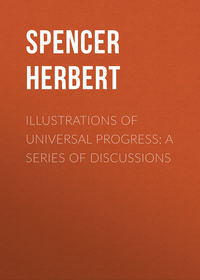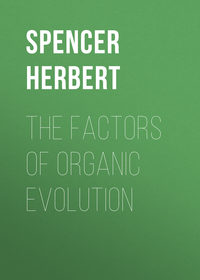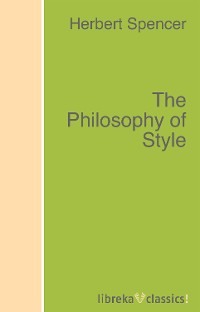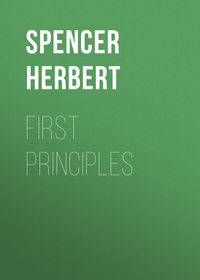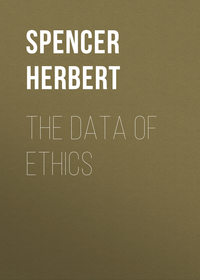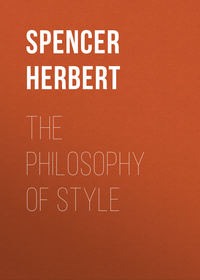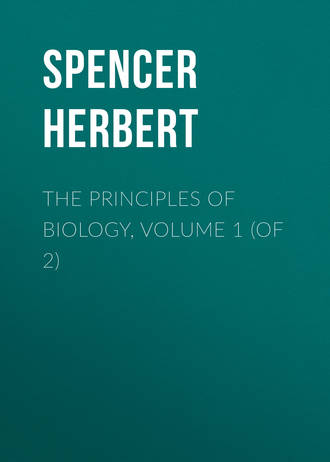 полная версия
полная версияThe Principles of Biology, Volume 1 (of 2)
Here seems a fit place for remarking that there are certain processes which do not enter into these re-equilibrations but in a sense interfere with them. One example must suffice. Among dogs may be observed the trick of rolling on some mass having a strong animal smell: commonly a decaying carcase. This trick has probably been derived from the trick of rolling on the body of an animal caught and killed, and so gaining a tempting odour. A male dog which first did this, and left a trail apt to be mistaken for that of prey, would be more easily found by a female, and would be more likely than others to leave posterity. Now such a trick could have no relation to better maintenance of the moving equilibrium, and might very well arise in a dog having no superiority. If it arose in one of the worst it would be eliminated from the species, but if it arose in one of medium constitution, fairly capable of self-preservation, it would tend to produce survival of certain of the less fit rather than the fittest. Probably there are many such minor traits which are in a sense accidental, and are neither adaptive nor specific in the ordinary sense.
§ 174h. But now let it be confessed that though all phenomena of organic evolution must fall within the lines above indicated, there remain many unsolved problems.
Take as an instance the descent of the testes in the Mammalia. Neither direct nor indirect equilibration accounts for this. We cannot consider it an adaptive change, since there seems no way in which the production of sperm-cells, internally carried on in a bird, is made external by adjustment to the changed requirements of mammalian life. Nor can we ascribe it to survival of the fittest; for it is incredible that any mammal was ever advantaged in the struggle for life by this changed position of these organs. Contrariwise, the removal of them from a place of safety to a place of danger, would seem to be negatived by natural selection. Nor can we regard the transposition as a concomitant of re-equilibration; since it can hardly be due to some change in the general physiological balance.
An example of another order is furnished by the mason-wasp. Several instincts, capacities, peculiarities, which are in a sense independent though they cooperate to the same end, are here displayed. There is the instinct to build a cell of grains of sand, and the ability to do this, which though in a sense separate may be regarded as an accompaniment; and there is the secretion of a cement – a physiological process not directly connected with the psychological process. After oviposition there comes into play the instinct to seek, carry home, and pack into the cell, the small caterpillars, spiders, &c., which are to serve as food for the larva; and then there is the instinct to sting each of them at a spot where the injected hypnotic poison keeps the creature insensible though alive till it is wanted. These cannot be regarded as parts of a whole developed in simultaneous coordination. There is no direct connexion between the building instinct and the hypnotizing instinct; still less between these instincts and the associated appliances. What were the early stages they passed through imagination fails to suggest. Their usefulness depends on their combination; and this combination would seem to have been useless until they had all reached something like their present completeness. Nor can we in this case ascribe anything to the influence of teaching by imitation, supposed to explain the doings of social insects; for the mason-wasp is solitary.
Thus the process of organic evolution is far from being fully understood. We can only suppose that as there are devised by human beings many puzzles apparently unanswerable till the answer is given, and many necromantic tricks which seem impossible till the mode of performance is shown; so there are apparently incomprehensible results which are really achieved by natural processes. Or, otherwise, we must conclude that since Life itself proves to be in its ultimate nature inconceivable, there is probably an inconceivable element in its ultimate workings.
END OF VOL. IAPPENDICES
APPENDIX A.
THE GENERAL LAW OF ANIMAL FERTILITY
[In the Westminster Review for April, 1852, I published an essay under the title "A Theory of Population deduced from the General Law of Animal Fertility." That essay was the germ of Part VI of this work, "The Laws of Multiplication," in which its essential theses are fully developed. When developing them, I omitted some portions of the original essay – one which was not directly relevant, and another which contained a speculation open to criticism. As indicated in § 74f, I find that this speculation has an unexpected congruity with recent results of inquiry. I therefore decide to reproduce it here along with the definition of Life propounded in that essay, which, though subsequently replaced by the definition elaborated in Part I, contains an element of truth.]
* * * * *Some clear idea of the nature of Life itself, must, indeed, form a needful preliminary. We may be sure that a search for the influences determining the maintenance and multiplication of living organisms, cannot be successfully carried out unless we understand what is the peculiar property of a living organism – what is the widest generalization of the phenomena that indicate life. By way of preparation, therefore, for the Theory of Population presently to be developed, we propose devoting a brief space to this prior question.
* * * * *Employing the term, then, in its usual sense, as applicable only to organisms, Life may be defined as —the co-ordination of actions. The growth of a crystal, which is the highest inorganic process we are acquainted with, involves but one action – that of accretion. The growth of a cell, which is the lowest organic process, involves two actions – accretion and disintegration – repair and waste – assimilation and oxidation. Wholly deprive a cell of oxygen, and it becomes inert – ceases to manifest vital phenomena; or, as we say, dies. Give it no matter to assimilate, and it wastes away and disappears, from continual oxidation. Evidently, then, it is in the balance of these two actions that the life consists. It is not in the assimilation alone; for the crystal assimilates: neither is it in the oxidation alone; for oxidation is common to inorganic matter: but it is in the joint maintenance of these – the co-ordination of them. So long as the two go on together, life continues: suspend either of them, and the result is – death.
The attribute which thus distinguishes the lowest organic from the highest inorganic bodies, similarly distinguishes the higher organisms from the lower ones. It is in the greater complexity of the co-ordination – that is, in the greater number and variety of the co-ordinated actions – that every advance in the scale of being essentially consists. And whether we regard the numerous vital processes carried on in a creature of complex structure as so many additional processes, or whether, more philosophically, we regard them as subdivisions of the two fundamental ones – oxidation and accretion – the co-ordination of them is still the life. Thus turning to what is physiologically classified as the vegetative system, we see that stomach, lungs, heart, liver, skin, and the rest, must work in concert. If one of them does too much or too little – that is, if the co-ordination be imperfect – the life is disturbed; and if one of them ceases to act – that is, if the co-ordination be destroyed – the life is destroyed. So likewise is it with the animal system, which indirectly assists in co-ordinating the actions of the viscera by supplying food and oxygen. Its component parts, the limbs, senses, and instruments of attack or defence must perform their several offices in proper sequence; and further, must conjointly minister to the periodic demands of the viscera, that these may in turn supply blood. How completely the several attributes of animal life come within the definition, we shall best see on going through them seriatim.
Thus Strength results from the co-ordination of actions; for it is produced by the simultaneous contraction of many muscles and many fibres of each muscle; and the strength is great in proportion to the number of these acting together – that is, in proportion to the co-ordination. Swiftness also, depending partly on strength, but requiring also the rapid alternation of movements, equally comes under the expression; seeing that, other things equal, the more quickly sequent actions can be made to follow each other, the more completely are they co-ordinated. So, too, is it with Agility; the power of a chamois to spring with safety from crag to crag implies accurate co-ordination in the movements of many different muscles, and a due subordination of them all to the perceptions. The definition similarly includes Instinct, which consists in the uniform succession of certain actions or series of actions after certain sensations or groups of sensations; and that which surprises us in instinct is the accuracy with which these compound actions respond to these compound sensations; that is – the completeness of their co-ordination. Thus, likewise, is it with Intelligence, even in its highest manifestations. That which we call rationality is the power to combine, or co-ordinate a great number and a great variety of complex actions for the achievement of a desired result. The husbandman has in the course of years, by drainage and manuring, to bring his ground into a fertile state; in the autumn he must plough, harrow, and sow, for his next year's crop; must subsequently hoe and weed, keep out cattle, and scare away birds; when harvest comes, must adapt the mode and time of getting in his produce to the weather and the labour market; he must afterwards decide when, and where, and how to sell to the best advantage; and must do all this that he may get food and clothing for his family. By properly coordinating these various processes (each of which involves many others) – by choosing right modes, right times, right quantities, right qualities, and performing his acts in right order, he attains his end. But if he have done too little of this, or too much of that; or have done one thing when he should have done another – if his proceedings have been badly co-ordinated – that is, if he have lacked intelligence – he fails.
We find, then, that the co-ordination of actions is a definition of Life, which includes alike its highest and its lowest manifestations; and not only so, but expresses likewise the degree of Life, seeing that the Life is high in proportion as the co-ordination is great. Proceeding upwards, from the simplest organic cell in which there are but two interdependent actions, on through the group in which many such cells are acting in concert, on through the higher group in which some of these cells assume mainly the respiratory and others the assimilative function – proceeding still higher to organisms in which these two functions are subdivided into many others, and in which some cells begin to act together as contractile fibres; next to organisms in which the visceral division of labour is carried yet further, and in which many contractile fibres act together as muscles – ascending again to creatures that combine the movements of several limbs and many bones and muscles in one action; and further, to creatures in which complex impressions are followed by the complex acts we term instinctive – and arriving finally at man, in whom not only are the separate acts complex, but who achieves his ends by combining together an immense number and variety of acts often extending through years – we see that the progress is uniformly towards greater co-ordination of actions. Moreover, this co-ordination of actions unconsciously constitutes the essence of our common notion of life; for we shall find, on inquiry, that when we infer the death of an animal, which does not move on being touched, we infer it because we miss the usual co-ordination of a sensation and a motion: and we shall also find, that the test by which we habitually rank creatures high or low in the scale of vitality is the degree of co-ordination their actions exhibit.
* * * * *There remains but to notice the objection which possibly may be raised, that the co-ordination of actions is not life, but the ability to maintain life. Lack of space forbids going into this at length. It must suffice to say, that life and the ability to maintain life will be found the same. We perpetually expend the vitality we have that we may continue our vitality. Our power to breathe a minute hence depends upon our breathing now. We must digest during this week that we may have strength to digest next. That we may get more food, we must use the force which the food we have eaten gives us. Everywhere vigorous life is the strength, activity, and sagacity whereby life is maintained; and equally in descending the scale of being, or in watching the decline of an invalid, we see that the ebbing away of life is the ebbing away of the ability to preserve life.62
[Only on now coming to re-read the definition of Life enunciated at the commencement of this essay with the arguments used in justification of it, does it occur to me that its essential thought ought to have been incorporated in the definition of Life given in Part I. The idea of co-ordination is there implied in the idea of correspondence, but the idea of co-ordination is so cardinal a one that it should be expressed not by implication but overtly. It is too late to make the required amendment in the proper place, for the first part of this work is already stereotyped and printed. Being unable to do better I make the amendment here. The formula as completed will run: – The definite combination of heterogeneous changes, both simultaneous and successful, co-ordinated into correspondence with external co-existences and sequences.]
* * * * *Ending here this preliminary dissertation, let us now proceed to our special subject.
§ 1. On contemplating its general circumstances, we perceive that any race of organisms is subject to two sets of conflicting influences. On the one hand by natural death, by enemies, by lack of food, by atmospheric changes, &c., it is constantly being destroyed. On the other hand, partly by the strength, swiftness and sagacity of its members, and partly by their fertility, it is constantly being maintained. These conflicting sets of influences may be conveniently generalized as – the forces destructive of race, and the forces preservative of race.
§ 2. Whilst any race continues to exist, the forces destructive of it and the forces preservative of it must perpetually tend towards equilibrium. If the forces destructive of it decrease, the race must gradually become more numerous, until, either from lack of food or from increase of enemies, the destroying forces again balance the preserving forces. If, reversely, the forces destructive of it increase, then the race must diminish, until, either from its food becoming relatively more abundant, or from its enemies dying of hunger, the destroying forces sink to the level of the preserving forces. Should the destroying forces be of a kind that cannot be thus met (as great change of climate), the race, by becoming extinct, is removed out of the category. Hence this is necessarily the law of maintenance of all races; seeing that when they cease to conform to it they cease to be.
Now the forces preservative of race are two – ability in each member of the race to preserve itself, and ability to produce other members – power to maintain individual life, and power to propagate the species. These must vary inversely. When, from lowness of organization, the ability to contend with external dangers is small, there must be great fertility to compensate for the consequent mortality; otherwise the race must die out. When, on the contrary, high endowments give much capacity of self-preservation, there needs a correspondingly low degree of fertility. Given the dangers to be met as a constant quantity; then, as the ability of any species to meet them must be a constant quantity too, and as this is made up of the two factors – power to maintain individual life and power to multiply – these cannot do other than vary inversely.
§ 3. To show that observed phenomena harmonise with this à priori principle seems scarcely needful But, though axiomatic in its character, and therefore incapable of being rendered more certain, yet illustrations of the conformity to it which nature everywhere exhibits, will facilitate the general apprehension of it.
In the vegetable kingdom we find that the species consisting of simple cells, exhibit the highest reproductive power. The yeast fungus, which in a few hours propagates itself throughout a large mass of wort, offers a familiar example of the extreme rapidity with which these lowly organisms multiply. In the Protococcus nivalis, a microscopic plant which in the course of a night reddens many square miles of snow, we have a like example; as also in the minute Algæ, which colour the waters of stagnant pools. The sudden appearance of green films on damp decaying surfaces, the spread of mould over stale food, and the rapid destruction of crops by mildew, afford further instances. If we ascend a step to plants of appreciable size, we still find that in proportion as the organization is low the fertility is great. Thus of the common puff-ball, which is little more than a mere aggregation of cells, Fries says, "in a single individual of Reticularia maxima, I have counted (calculated?) 10,000,000 sporules." From this point upwards, increase of bulk and greater complexity of structure are still accompanied by diminished reproductive power; instance the Macrocystis pyrifera, a gigantic sea-weed, which sometimes attains a length of 1500 feet, of which Carpenter remarks, "This development of the nutritive surface takes place at the expense of the fructifying apparatus, which is here quite subordinate."63 And when we arrive at the highly-organized exogenous trees, we find that not only are they many years before beginning to bear with any abundance, but that even then they produce, at the outside, but a few thousand seeds in a twelvemonth. During its centuries of existence, an oak does not develop as many acorns as a fungus does spores in a single night.
Still more clearly is this truth illustrated throughout the animal kingdom. Though not so great as the fertility of the Protophyta, which, as Prof. Henslow says, in some cases passes comprehension, the fertility of the Protozoa is yet almost beyond belief. In the polygastric animalcules spontaneous fission takes place so rapidly that "it has been calculated by Prof. Ehrenberg that no fewer than 268 millions might be produced in a month from a single Paramecium;"64 and even this astonishing rate of increase is far exceeded in another species, one individual of which, "only to be perceived by means of a high magnifying power, is calculated to generate 170 billions in four days."65 Amongst the larger organisms exhibiting this lowest mode of reproduction under a modified form – that of gemmation – we see that, though not nearly so rapid as in the Infusoria, the rate of multiplication is still extremely high. This fact is well illustrated by the polypes; and in the apparent suddenness with which whole districts are blighted by the Aphis (multiplying by internal gemmation), we have a familiar instance of the startling results which the parthenogenetic process can achieve. Where reproduction becomes occasional instead of continuous, as it does amongst higher creatures, the fertility equally bears an inverse ratio to the development. "The queen ant of the African Termites lays 80,000 eggs in twenty-four hours; and the common hairworm (Gordius) as many as 8,000,000 in less than one day."66 Amongst the Vertebrata the lowest are still the most prolific. "It has been calculated," says Carpenter, "that above a million of eggs are produced at once by a single codfish."67 In the strong and sagacious shark comparatively few are found. Still less fertile are the higher reptiles. And amongst the Mammalia, beginning with small Rodents, which quickly reach maturity, produce large litters, and several litters in the year; advancing step by step to the higher mammals, some of which are long in attaining the reproductive age, others of which produce but one litter in a year, others but one young one at a time, others who unite these peculiarities; and ending with the elephant and man, the least prolific of all, we find that throughout this class, as throughout the rest, ability to multiply decreases as ability to maintain individual life increases.
§ 4. The à priori principle thus exemplified has an obverse of a like axiomatic character. We have seen that for the continuance of any race of organisms it is needful that the power of self-preservation and the power of reproduction should vary inversely.
We shall now see that, quite irrespective of such an end to be subserved, these powers could not do otherwise than vary inversely. In the nature of things species can subsist only by conforming to this law; and equally in the nature of things they cannot help conforming to it.
Reproduction, under all its forms, may be described as the separation of portions of a parent plant or animal for the purpose of forming other plants or animals. Whether it be by spontaneous fission, by gemmation, or by gemmules; whether the detached products be bulbels, spores or seeds, ovisacs, ova or spermatozoa; or however the process of multiplication be modified, it essentially consists in the throwing off of parts of adult organisms for the purpose of making new organisms. On the other hand, self preservation is fundamentally a maintenance of the organism in undiminished bulk. Amongst the lowest forms of life, aggregation of tissue is the only mode in which the self-preserving power is shown. Even in the highest, sustaining the body in its integrity is that in which self-preservation most truly consists – is the end which the widest intelligence is indirectly made to subserve. Whilst, on the one side, it cannot be denied that the increase of tissue constituting growth is self-preservation both in essence and in result; neither can it, on the other side, be denied that a diminution of tissue, either from injury, disease, or old age, is in both essence and result the reverse.
Hence the maintenance of the individual and the propagation of the race being respectively aggregative and separative, necessarily vary inversely. Every generative product is a deduction from the parental life; and, as already pointed out, to diminish life is to diminish the ability to preserve life. The portion thrown off is organised matter; vital force has been expended in the organisation of it, and in the assimilation of its component elements; which vital force, had no such portion been made and thrown off, would have been available for the preservation of the parent.
Neither of these forces, therefore, can increase, save at the expense of the other. The one draws in and incorporates new material; the other throws off material previously incorporated. The one adds to; the other takes from. Using a convenient expression for describing the facts (though one that must not be construed into an hypothesis), we may say that the force which builds up and repairs the individual is an attractive force, whilst that which throws off germs is a repulsive force. But whatever may turn out to be the true nature of the two processes, it is clear that they are mutually destructive; or, stating the proposition in its briefest form – Individuation and Reproduction are antagonistic.
Again, illustrating the abstract by reference to the concrete, let us now trace throughout the organic world the various phases of this antagonism.
§ 5. All the lowest animal and vegetable forms —Protozoa and Protophyta– consist essentially of a single cell containing fluid, and having usually a solid nucleus. This is true of the Infusoria, the simplest Entozoa, and the microscopic Algæ and Fungi. The organisms so constituted uniformly multiply by spontaneous fission. The nucleus, originally spherical, becomes elongated, then constricted across its smallest diameter, and ultimately separates, when "its divisions," says Prof. Owen, describing the process in the Infusoria, "seem to repel each other to positions equidistant from each other, and from the pole or end of the body to which they are nearest. The influence of these distinct centres of assimilation is to divert the flow of the plasmatic fluid from a common course through the body of the polygastrian to two special courses about those centres. So much of the primary developmental process is renewed, as leads to the insulation of the sphere of the influence of each assimilative centre from that of the other by the progressive formation of a double party wall of integument, attended by progressive separation of one party wall from the other, and by concomitant constriction of the body of the polygastrian, until the vibratile action of the superficial cilia of each separating moiety severs the narrowed neck of union, and they become two distinct individuals."68 Similar in its general view is Dr. Carpenter's description of the multiplication of vegetable cells, which he says divide, "in virtue, it may be surmised, of a sort of mutual repulsion between the two halves of the endochrome (coloured cell-contents) which leads to their spontaneous separation."69 Under a modified form of this process, the cell-contents, instead of undergoing bisection, divide into numerous parts, each of which ultimately becomes a separate individual. In some of the Algæ "a whole brood of young cells may thus be at once generated in the cavity of the parent-cell, which subsequently bursts and sets them free."70 The Achlya prolifera multiplies after this fashion. Amongst the Fungi, too, the same mode of increase is exemplified by the Protococcus nivalis. And "it would appear that certain Infusoria, especially the Kolpodinæ, propagate by the breaking-up of their own mass into reproductive particles."71



